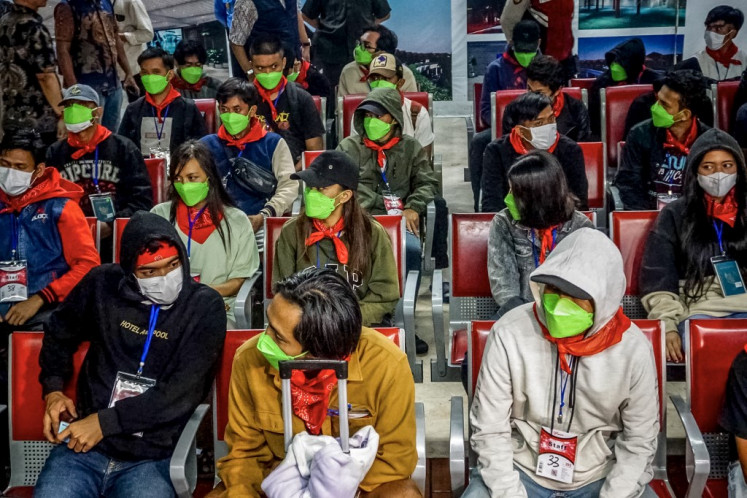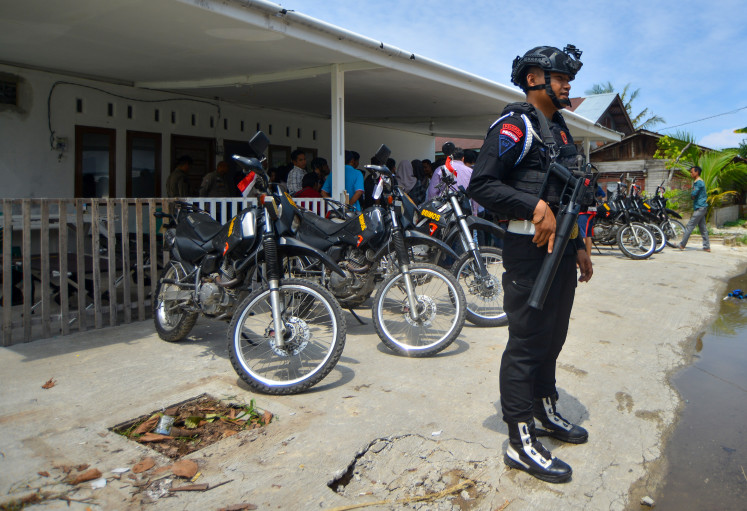Popular Reads
Top Results
Can't find what you're looking for?
View all search resultsPopular Reads
Top Results
Can't find what you're looking for?
View all search resultsRevenge of Banyuwangi's Ninjas
Moral panic is a ghastly phenomenon â and no culture seems immune
Change text size
Gift Premium Articles
to Anyone
Moral panic is a ghastly phenomenon ' and no culture seems immune.
Moral panic happens when a bizarre but unproven story is fed by wild rumors which result in persecution.
The Massachusetts Salem witch trials of the late 17th century in the US are among the most famous; more recent examples include the 1980 Lindy Chamberlain dingo-baby case in Australia.
In 1998, the sickness struck villages around East Java town Banyuwangi, notoriously known as the 'warehouse of sorcery', when around 100 people, including five women, died.
They were slaughtered at night, usually with sickening brutality and their corpses sometimes mutilated, by mobs inflamed by claims the victims were casting spells and causing harm.
The killers, often preman [criminal thugs] among the outraged locals, were said to have wrapped sarongs around their heads as disguise. At the time, American comics featuring similarly dressed fictitious Ninja Turtles were popular, so the murderers were dubbed Ninjas. But there was nothing amusing about these characters.
There were as many explanations as victims, but the most popular was the conspiracy theory, with a wide range of masterminds from the army through to 'mysterious forces'.
Australian academic Dr Nicholas Herriman will not buy these notions as shown in his book, Witch-hunt and Conspiracy, even though they had credibility among some of his colleagues. Understandable because: 'in Indonesia conspiracies generally lie beneath unusual social, economic, political and, especially violent phenomena'.
He found no evidence of tension between religions; nor does he accept that local economic crises were at fault. Another idea that Muslim preachers, who were often large landowners, were targeted is also dismissed.
For Herriman, a chance confluence of disparate factors created an environment where weird rumors gained credibility and spawned other fantasies. These led to the breakdown of the moral principles that normally sustain communities. Dark matter indeed.
How can otherwise civilized people living in harmony lose their humanity and turn into frenzied beasts?
In faraway Jakarta, president Soeharto had been dethroned; the political world was in turmoil. This fear and uncertainty tilled fertile ground for accusations of sorcery to take root. The collapse of the New Order government undermined law and order. This created opportunities for grudge holders to take revenge against neighbors with reduced chances of retribution.
Reports Herriman: 'While I often sensed that people feared a local 'sorcerer', through all my interviews I did not obtain data that equated this fear with the 'terror' that is the 'human condition'. Informants seemed to evince a sense of relief following the removal of the 'sorcerer'.'
Reformasi also liberated the media long shackled by an authoritarian regime. Not all reporters swallowed their essential scepticism pills before venturing into the field to check Ninja stories.
Unfettered tabloid journalism fed well on the killings and in turn enriched the paranoia in isolated communities with limited access to wider views and little trust in modern medicine.
Rational explanations for illness ' frequently a distended stomach ' or sudden deaths of livestock or people were discarded in favor of supernatural causes. As the gossip spread so did panic, with villagers setting up roadblocks to catch ninjas.
Individual and community ills were projected onto the victims. Some were mentally sick; others just different from the norm in small communities by being lucky or successful and so arousing jealousy. The excuse of 'community justice' was often used.
When tales about neighbors dancing naked in cemeteries were whispered, it seems no-one was prepared to ridicule the reports. If they did, they became suspects. Ancient rituals were revived, like the 'shrouded oath' where the Koran is chanted over a person wrapped in a winding sheet who swears never to ensorcel again ' 'or let me die like this'.
Just as medieval European witch-ducking 'proved' survivors were evil and so had to be killed while the innocent drowned anyway, the same twisted reasoning applied in Banyuwangi. One victim was stabbed but didn't die, saved by his 'magical powers'. These demonstrated that he was a sorcerer.
If an accused heard they'd been marked for murder and fled, this showed absence of innocence. If they stayed it meant they accepted their guilt.
For foreigners the Ninja killings indicated that Indonesian rural society hadn't shifted much beyond the primitive beliefs of the European Middle Ages.
But those who've lived long in the archipelago know better than to apply Western logic to chance happenings, even without having their brains curdled by watching sinetron TV soap opera plots that often feature demon doings.
Beliefs in the paranormal lie close to the surface even among the well-educated. During the 2009 election, former president Susilo Bambang Yudhoyono told the Antara news agency: 'Many are practising black magic. Indeed my family and I can feel it.'
At times it seems that almost everyone knows an unfortunate friend-of-a-friend suffering after being cursed by a colleague they've offended.
Herriman's accounts and analysis of the events were undertaken for a doctoral thesis. He lived in the community and interviewed around 150 people; these included men jailed for taking part in the killings [most got light sentences], relatives of the victims, religious heads and community leaders.
'I became conscious of, unwittingly involved and almost carried away in this world of fear and suspicion.'
The author began his research believing that a 'conspiracy of some kind' lay behind the killings and set about searching for the evidence. He didn't find it. He consulted a dukun [shaman] about his future career ' would it be in the US, Japan or Australia? He was told the first two. He now teaches anthropology in Melbourne.
The killings abruptly stopped when the police and Army, prompted by the media, intervened. Only three of the 250 men charged were acquitted.
That should be the end of the story, but like vampires who rise from their crypt with the full moon for their next draught of haemoglobins, so the Banyuwangi ninjas will live on so long as ancient irrational fears trump common sense.










